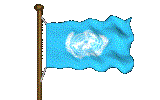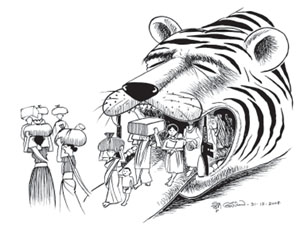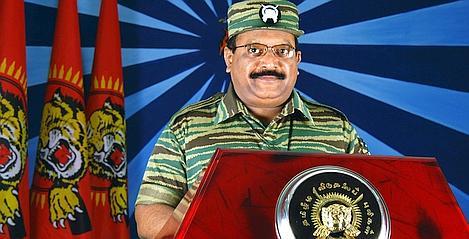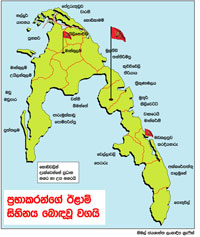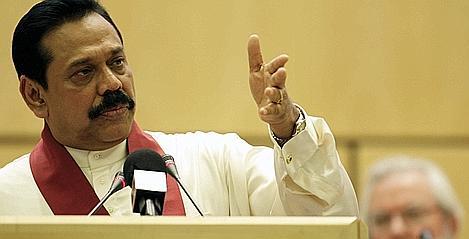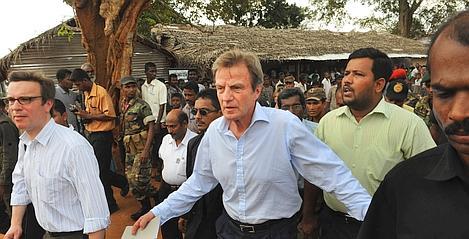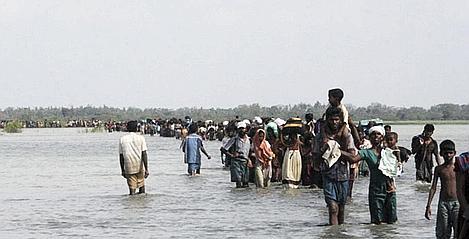
Sri lanka Wednesday, April 29th 2009
The Tigers, the guerrilla's most sophisticated Quarteroni a recluse in the jungle
Caroline Stevan
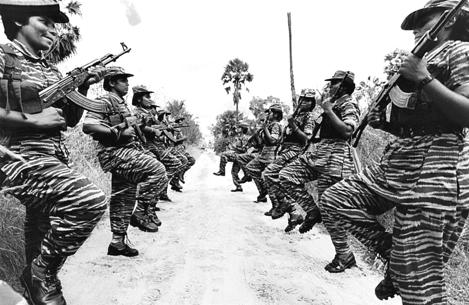
Hunted by the army, the Tamil rebels is now living its last days. Origin and characteristics
It gives them a few days, weeks at most. Cornered by the Sri Lankan army, the Tamil Tigers are in the process of making their last breath. Review of the characteristics of this guerrilla for long time presented as the most ferocious and best organized of the world.
The beginnings of the struggle
Regarded as better educated and more English than the Sinhalese, the Ceylon Tamil minority (15% of the population) has been widely favored by the occupying British. The independence of the island in 1948, the Sinhalese resume control of the state and begin to bully the elite decommissioned. In 1956, Sinhala is recognized as the sole language of the country, it is the beginning of the fight. The anti-Tamil attacks fuel the ranks of the rebellion. Among the younger generation of fighters emerged Velupillai Prabhakaran. Aged 22 years in 1976, he founded the Tamil New Tigers, which will become in 1976 the Liberation Tigers of Tamil Eelam (LTTE). On Marxist, the focus is the independence of the Tamil north of the island.
Methods
The Tigers begin with small attacks targeted police posts in particular, before eliminations political practice on a large scale. In 1975, the mayor of Jaffna was assassinated. Followed by many elected officials, some ministers, the head of the Government of India Rajiv Gandhi in 1991 and Sri Lankan President Ranasinghe Premadasa in 1993. The other Tamil movements are eliminated with the same method. The guerrilla suicide bomber gives practice in fashion, including using women. "With more than 450 suicide attacks in a quarter century, we can say they have industrialized this technique," says Olivier Guillard, research director at the Institute of International and Strategic Relations (IRIS) in Paris. There is also a more conventional arsenal: Tigers are the only rebel group of the world with their fleet and some aircraft. "Three years ago, this was the guerrillas more operational and better trained on the planet," notes Olivier Guillard. Troops, and are divided into several bodies, the Black Tigers, who commit suicide bombings, the Sea Tigers, who command ships.
Beyond the sophistication of the explosives or the accuracy of their snipers, we can see the immense cruelty of their methods, for its part, emphasizes Jean-Vincent Brisset, military expert, also a researcher at IRIS . It lends particular the practice of "barbecue Tamil", a Sinhalese set of two tires that boute on fire." Tigers, moreover, are known for always wearing them a cyanide capsule to swallow case of capture. "The meaning of heroism and sacrifice are very present in the Tamil culture. Velupillai Prabhakaran has taken to the extreme, "says Eric Meyer, Vice-President of the Inalco (Paris Institute of Oriental Languages) and a specialist in Sri Lanka.
Organizational Structure
Velupillai Prabhakaran remains the undisputed leader. The whole movement turn around it. It is said megalomaniac, exclusive and deadly. In addition to the senior movement, the LTTE are composed of many soldiers, often recruited by exercising some coercive among the Tamil population. "In the territories controlled by the Tigers, each family has more or less obliged to sacrifice one member to the organization, often a child," says Alan Keenan, an analyst at Colombo for International Crisis Group. Number of children were recruited into the guerrilla. Rumor has it that many orphans have been "taken" after the tsunami in December 2004. "The Tigers have set up orphanages after the tsunami. These homes have to be places of indoctrination, like schools, but this is not a systematic policy, "notes Eric Meyer. The LTTE has created a kind of small state in the territories they control, with their police, their legal system or their taxes.
Funding
The LTTE is heavily watered by the diaspora, again in a more or less voluntary, and a monthly fee is levied at the Tamils from abroad. The other source of funding is derived from crime, arms trafficking and racketeering in mind.
Support
Diaspora, therefore, plays a huge role, both in financial terms as in mobilizing international public opinion. Demonstrations to support the Tamil cause are regularly organized. Tyrannize by the Tigers, the Tamil population of Sri Lanka seems to continue to support them, at least openly. "They have little choice in their mind, it is the LTTE or the government! Having eliminated all their rivals, the Tigers are the only ones to defend the Tamil cause, "argues Alan Keenan. The LTTE, too, have supported India in the 1980s in particular. Many cadres of the movement went into exile a time in Tamil Nadu near. The signing of an agreement between New Delhi and Colombo in 1987, to end separatism, broke off relations. India has deployed its troops in Sri Lanka against the LTTE.
The debacle
Relentlessly bombed by the Sri Lankan army, the Tigers are now confined to an area of 10 sq km in north-east. "A series of strategic errors have led the organization to this military dead end ; ranking in the blacklist of terrorist organizations (2006), which meant that it was concerned about the funding of the LTTE, the assassination of Rajiv Gandhi, who has cut the movement of the support of India, coastal monitoring relaxed ... "lists Eric Meyer. "The departure of Karuna, the Tigers number two who joined the government in 2004, led to the desertion of several executives. This was the beginning of the end, "says his side Eleanor Pavey, a specialist in Sri Lanka in Geneva. Finally, a new government was established in Colombo, with the will to fight. The means granted to the army have increased since 2005. Estimated between 5000 and 10 000 members there are still few, the Tigers would be more than 300 to 500 according to the Government, 1500 to 2000 according to observers.
The future
Velupillai Prabhakaran had asked his guards to shoot as a last resort. He also appointed a dolphin, Kumaran Pathmanathan, supplier of weapons known as KP, sailing between Thailand, Malaysia and Europe. The army will likely handle the Tigers. But if the "solution" is only military, the Tamil question may well emerge from the jungle or from abroad.
(True Story of LTTE from the time the Journal 29.04.2009
|




